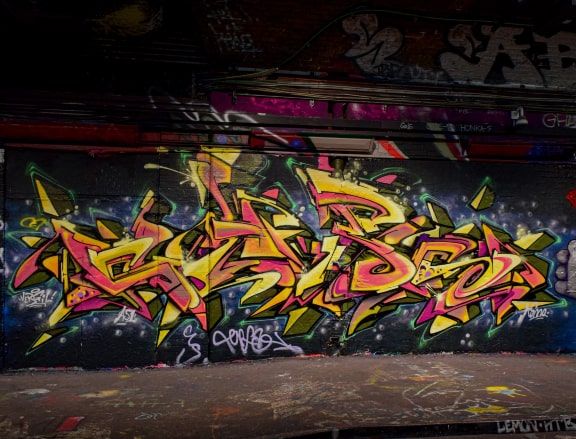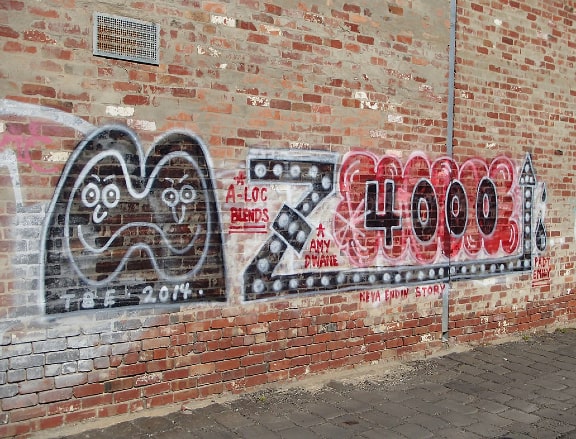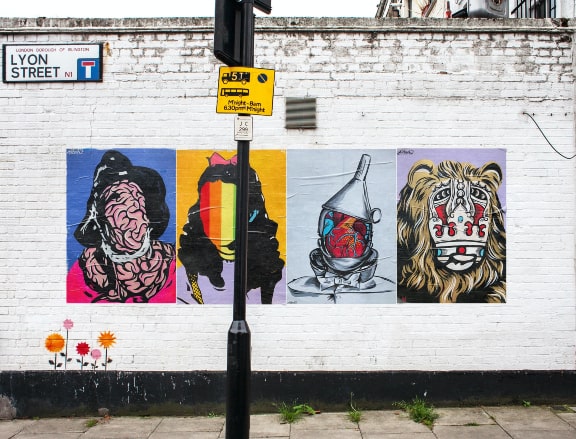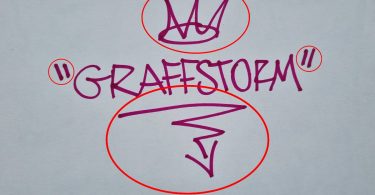From the outside looking in, graffiti writing seems chaotic and mindless.
It’s almost as if there are no rules that graffiti artists follow when they paint.
But what if I told you that instead of rules, there is style.
And depending on what style graffiti artists choose, there are techniques they need to follow if they want to be respected.
Find out about the top 18 most popular graffiti styles you need to know, what defines them and what makes them unique.
1. Tags

A tag can be defined as a stylised signature of the graffiti artist’s name, often done quickly on a public surface.
Tags are the most common style of graffiti and often the starting point for new graffiti artists.
Tags can be found in every graffiti culture worldwide because they’re the earliest method of modern-day graffiti – with graffiti writers like Cornbread from Philadelphia being the first to do a graffiti tag in 1965.
Some claim that without tags, we wouldn’t have vibrant, detailed and colourful graffiti such as murals.
This is because most graffiti artists’ work originates from a single tag. And as artists evolve their style, their name becomes more stylised to include elements like 3D effects and colours.
The most common tools for graffiti tags include spray paint and marker pens.
2. Throw-ups

Throw-ups are a style of graffiti characterised by rounded bubble letters with minimal negative space painted quickly (or ‘thrown-up’) on a surface.
The throw-up is usually the next progression from a tag.
This comes as graffiti artists get more familiar with letter structures and strive for their names to be painted bigger, whilst also maintaining speed.
By avoiding negative space, sharp edges and intricate details, throw-ups are able to be painted quickly.
Throw-ups contain two colours of paint – one for the fill and one for the outline.
High pressure spray paint is the medium of choice for throw-ups as the high output allows for maximum speed.
3. Two letter throw-ups

Two letter throw-ups share a similar style to regular throw-ups, but they instead only contain two letters of the graffiti writer’s tag. Most commonly, the first two letters.
This style of throw-up allows graffiti writers to paint their names up even faster, whilst also being able to fit into smaller spaces where a full throw-up isn’t possible.
JA One from New York and Oker from London are two infamous graffiti artists who are well known for their two letter throw-ups.
4. Hollows

Hollows are similar to throw-ups, except they only feature the letter outline in one colour with no fill-in.
Hollows are another way to paint which allows for even more speed whilst also going big, all whilst being an efficient use of paint.
Hollow graffiti is notoriously hard, however, as it can be obvious when lines have been done poorly. With only one colour and no fill-in to hide any errors, it’s difficult to fix mistakes.
Because of their difficulty, hollows can be a good display of a graffiti artist’s skill as they require exceptional can control for them to look clean.
5. Straight Letters

A straight letter piece is defined by its big, bold and often more readable letters in combination with the graffiti artist’s personal flare.
This style of graffiti is commonly the next progression from a throw-up as it contains more detailed, sharper edges and has more negative space.
A straight letter is usually painted with speed in mind and uses only 2 – 4 colours in a piece.
In London graffiti culture, a straight letter piece painted with silver chrome and black is commonly known as a ‘Dub’.
6. Full Colour Pieces

A full colour piece is similar to a straight letter piece, but is much more stylised in appearance and contains more colours.
This style of graffiti is much more detailed and usually features a 3D or shadow, a background and sometimes a character depending on the artist’s style.
Spray paint is the essential medium for full colour pieces, although artists may also use emulsion paint with a paint roller to prepare the wall.
This gives them a neutral background so no graffiti underneath distracts from the piece.
7. Wildstyle

Wildstyle is one of the most advanced styles of graffiti, containing many complex and intricate details including letters usually only readable by other graffiti artists.
Elements like arrows, 3D, spikes, flares and sharp edges define wildstyle graffiti. However, to non-graffiti artists, these elaborate details can make it difficult to read the artist’s name.
As a strong display of a graffiti writer’s skill, the complexity of this style continues to evolve across the globe.
Legendary graffiti writer Tracy 168 (RIP) is widely known as being the king of wildstyle graffiti, having pushed this style in mid-1970s NYC across the subway system and the city walls.
8. Blockbuster

A blockbuster is a style of graffiti characterised by huge straight letters painted using only 2 – 3 colours.
Both spray paint and/or emulsion paint can be used to create blockbuster pieces.
Although a blockbuster can be painted anywhere, they’re commonly found on large surfaces that are distanced from public view.
This means that there is a need to go huge in order to be seen, as a normal-sized piece may be missed.
Common spots include highways, rooftops and abandoned buildings – but you can find blockbusters anywhere.
9. Murals

Murals are large pieces of street art containing faces, characters, objects, abstract designs and sometimes letters often painted with permission.
The line between graffiti and street art becomes blurred with murals, as the previous graffiti styles we’ve covered have been primarily name-based.
Murals do not always contain a name or a tag, which puts them more in the category of street art.
As murals are usually commissioned, artists are able to spend as much time as they need to perfect their work, which is often not the case for other graffiti styles.
Also unlike the other styles we’ve looked at, murals are usually painted for everyone to appreciate – not just graffiti artists.
Some mural artists aim to send a message, provoke a thought or pay tribute to someone or something through their work.
10. Roller graffiti

Roller graffiti (also known as roll-ups) is a style that uses emulsion paint along with paint rollers to produce big pieces in hard-to-reach places.
A big limitation of spray paint is that unless you have access to a ladder, you’re only able to paint as high as you can reach.
But by using an extended paint roller instead, graffiti artists can access spaces previously inaccessible with spray paint without needing a ladder.
Roller graffiti can be much cheaper too, as a bucket of emulsion paint goes much further than a can of spray paint.
11. Anti-style

Anti-style (also known as hipster graffiti and ignorant style) is a type of graffiti that completely ignores traditional graffiti conventions.
By ignoring these conventions, anti-style writers are strictly “against” any graffiti traditional style.
Although anti-style can be found around the world, it’s one of the rarer types of graffiti.
This is because many artists strive for respect and recognition, which is hard to achieve as an anti-style writer because this style only appeals to a small minority of graffiti artists.
Anti-style can be hard to look at as pieces lack composition and flow. With no rules to follow, anti-style can be produced using any type of graffiti paint.
12. Stickers

Sticker art (also known as sticker slapping and sticker bombing) is a common type of graffiti where artists either write on blank stickers or print names and images on stickers and stick them up in public.
Although originating in New York, this style of graffiti can be found all across the world.
Sticker art is unique as it’s not just used as a means of increasing someone’s profile through a tag like traditional graffiti.
Stickers are also often used to raise awareness of social issues and to promote political agendas.
Although some brands have designed stickers that are difficult to remove, sticker bombing is regarded as a minor form of graffiti.
This is because most stickers can be more easily peeled off compared to removing paint.
13. Stencils

Stencil graffiti or stencil art is a style that uses a sheet of card, plastic or metal with shapes cut out of it. Artists then put the sheet on a surface and use spray paint to fill in the cut-out shapes, producing their artwork.
Stencil graffiti was made famous by Banksy through his popular pieces Girl with Balloon and Flower Thrower.
Since then, stencil graffiti has become more popular and often inherits a political or social message which is aimed at the wider public.
In graffiti culture, stencils are not a well-respected type of graffiti due to the lack of skill needed to produce a stencil piece.
14. Heaven spot

Although not strictly a graffiti style, a heaven spot is a piece painted in a high-up and difficult place.
As the name suggests, heaven relates to being high up in the sky. But it’s also the place a writer might end up if they fall.
Heaven spots can range from rooftops, towers, highway signs and more. Pretty much any graffiti piece which is high up in the air.
Graffiti writers who are able to reach these spots are more likely to be seen and gain more respect for taking on the risk.
Both spray paint and emulsion paint are common tools for painting heaven spots.
15. Wheat paste

Wheat paste is a style that uses wheat flour or starch mixed with water to adhere paper imagery to a surface.
Like stencils, stickers and murals – wheat paste falls more into the category of street art than traditional graffiti. This is because it focuses on images and symbols instead of a graffiti name.
Wheat paste posters also often try to provoke a social or political message as they’re commonly used by activist groups to raise awareness for their cause.
16. Etch graffiti

Etched graffiti is a style where graffiti writers mix an acid solution into a marker pen to burn their tags on glass permanently.
Beyond the usual risks of graffiti, etching can be very dangerous as it involves the handling of corrosive acids.
Despite this, it’s a common style of graffiti that can be found worldwide – especially in major cities.
It’s also one of the most expensive forms of graffiti to remove as etched tags can’t be removed with cleaning products. Instead, the glass must be replaced.
This adds to its appeal as etched tags aren’t usually removed due to the cost of replacing an entire glass pane.
17. Calligraphy graffiti

Calligraphy graffiti (or calligraffiti) combines traditional calligraphy lettering with elements of graffiti culture.
This style of graffiti can be achieved using many different art supplies, such as calligraphy marker pens, calligraphy caps on spray paint and paintbrushes.
Because it’s possible to do with many different mediums, calligraphy graffiti can range from tags, straight letter pieces, full-colour pieces and murals.
18. Pichação

Pichação (pronounced pi-cha-ção) is a unique style of graffiti native to São Paulo.
Roughly translated to “wall writings”, Pichação is a form of tagging it’s known for its cryptic lettering painted in hard to reach places across cities in Brazil.
Although Pichação writing began in the 1970s as a form of political and social protest, modern Pichação writers instead use it as a way to promote their graffiti name – much like traditional name-based graffiti.
Pichação can be easily recognised by its thin and aggressive lettering made possible by the use of spray paint, paintbrushes and paint rollers.
So, there you have it – 18 iconic graffiti styles you’ll find worldwide. Did I miss any? Leave a comment and let me know.
Feeling inspired? Take a look at our top tips for finding your graffiti style.




